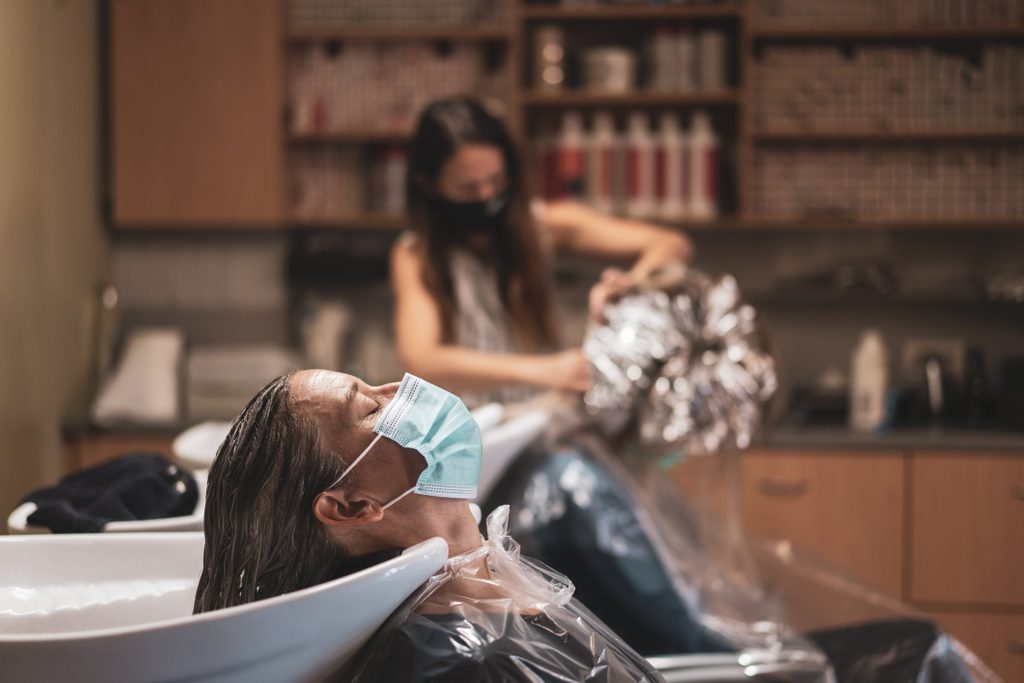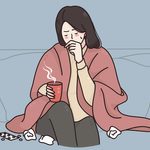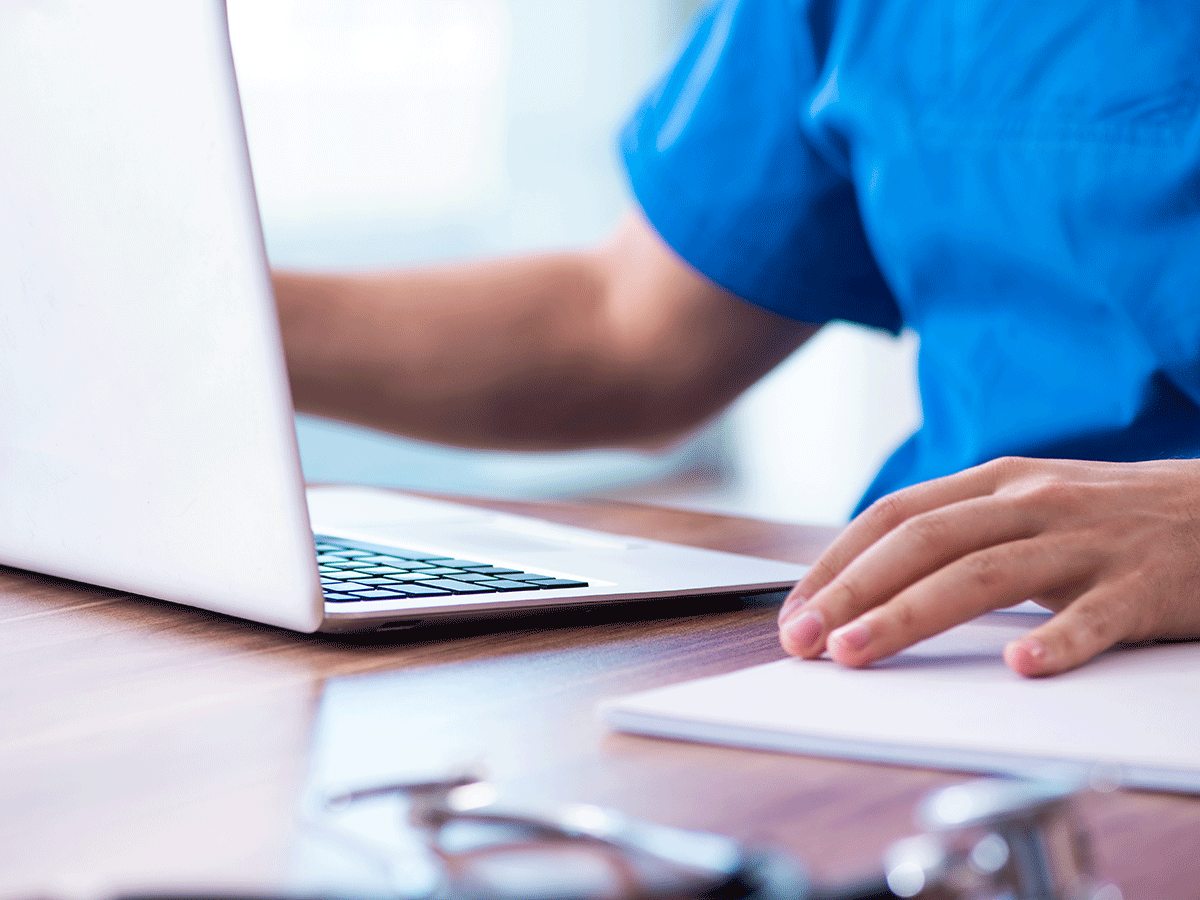I Had My First Hair Appointment Post-Quarantine—Here’s What It Was Like

When my salon reopened, I was ready to see my stylist. Here's what happened during my first hair appointment during the Covid-19 pandemic.
To be honest, I can get by without a haircut for several months. My wavy locks don’t require much maintenance except for a bang trim, but I have colour-treated hair that requires touch-ups every six weeks. When April rolled around and after weeks in quarantine, I had sprouted gray roots with a vengeance. I attempted to cover my roots with an at-home touch-up kit, but let’s just say it didn’t work out well.
Resolved to accept my grays, I quietly joined the other gals on social media in the “We’re in this together—embrace your gray roots during coronavirus!” campaign. But my vanity won out when I read my stylist’s post on Instagram saying her salon would be reopening soon. I live in Baltimore County, Maryland, and my salon is there too. The stage one reopening in my state was effective May 29, and hallelujah—my stylist was taking appointments for opening day.
Am I risking my health for vanity?
My giddiness at getting my hair done was short-lived once the reality set in that there was no way to social distance unless my stylist morphed into Edward Scissorhands to cut my bangs and colour my hair. I had a bad feeling in the pit of my stomach and was anxious contemplating the risk of getting sick or just as horrible, unknowingly giving coronavirus to my stylist. (The CDC estimates 40 percent of coronavirus transmission happen before people feel sick.)
Medical organizations won’t definitively say whether you should get a haircut or not, because one person’s risk isn’t the same as another’s. But Dr. Nikita Desai, a pulmonologist at Cleveland Clinic, is reassuring. “Getting a long-overdue haircut in a salon practising social distancing and thorough sanitation between clients is not equivalent to gathering in a group of 100 people indoors in a poorly ventilated building where no one is wearing a mask,” Dr. Desai says.
But don’t just dive in without giving it some thought first. “You should consider your own health risks and the health risks of those in your household with whom you have close contact on a regular basis,” says Saadia Griffith-Howard, MD, an infectious disease specialist for Kaiser Permanente. “You should also understand what precautions are being taken at the salon. Are they wearing masks, sanitizing between customers, performing temperature checks or spacing chairs, and limiting customers inside?”
Also, Dr. Griffith-Howard says, consider how long the service you want takes. “We know the risk of infection increases with the length of contact. Therefore, you may want to consider services that take less time.”
Who shouldn’t schedule a hair appointment
Unfortunately, we don’t always know if we’re sick with coronavirus. Locations like gyms, salons, and restaurants are locations where many people can be exposed at the same time, which is why we must exercise caution, says Dr. Desai. “A person is most infectious with the virus in the immediate one to two days before they present with symptoms, so it’s still possible that spread will occur. That’s why it is absolutely essential to wear a mask that covers your mouth and nose and to wash your hands frequently,” says Dr. Desai.
Still, Dr. Howard urges caution for anyone with health conditions that put them at increased risk of severe illness with Covid-19. “You should consider the risks you want to take. Going to a salon, even with precautions, has some risk. The best thing is to talk with your doctor about what is safe at this time given your health and the virus’s spread in your local community,” says Dr. Howard.
What should salons and barbershops do to minimize risk?
Every city has its own orders for reopening. Some places require salons and barbershops to operate at 50 percent capacity, including staff, and by appointment only and with appropriate health and safety guidelines. But what exactly does “appropriate health and safety guidelines mean?” The CDC lists reopening guidance for public spaces, such as salons and barbershops. More specific protocols include requiring clients to wait in their cars until their chair is ready, setting up prepay or self-pay stations, and installing portable HEPA filtration units.
Armed with plenty of info, I knew what my salon should be doing to protect clients and employees. Next, I checked my salon’s social media accounts and messaged my stylist to find out the steps my salon was taking to protect clients and staff from Covid-19.
What my salon is doing to minimize risk
There is a long list of safety measures my salon is taking to keep clients and employees safe from coronavirus:
- Staff will wear masks at all times.
- Clients use disposable eye protection.
- The salon is a glove-free zone.
- Keep a limited number of stylists and clients in the building.
- Stylists must be certified in Barbicide Covid-19 sanitation.
- Follow CDC guidelines for sanitation of tools and brushes.
- One employee handles laundry.
- The entire salon is sanitized and cleaned daily.
- Employees to maintain social distancing.
- Employees’ temperature is checked.
- Limit seating and retail handling.
- Limit number of stylists, and keep one empty workstation between clients.
- Have a separate bathroom for clients and employees.
- No coffee maker, water, refreshments, and magazines will be available.
- No touching retail shelves or products.
- Bring only your keys and wallet to the appointment.
- Come alone to the appointment, unless you are with a child under 10 years of age.
- Clients must maintain social distancing in the salon and in the outdoor waiting area.
Why the strict protocols?
The reason for so many safeguards comes down to mitigating risk of Covid-19. “With precautions in place, the risk to hairstylists and customers can be greatly reduced,” says Michael A. Ben-Aderet, MD, associate medical director of hospital epidemiology at Cedars-Sinai in Los Angeles.
“The theory behind all that is to establish policies that allow social distancing and allow for surfaces that are easy to clean. The problem with things like magazines and coffee makers in a public setting is they are very difficult if not impossible to totally sanitize, and those surfaces can be very high-touch and we know that respiratory droplets can get on surfaces and can last for an undetermined amount of time,” says Dr. Ben-Aderet.
What safety measures should I take?
Wear a mask and wash my hands—check. What else? What if I have to use the restroom? “Wash your hands after bathroom use and make sure not to re-contaminate them by touching faucets to turn off the water or touching the door handle. Use a clean paper towel if you must touch these surfaces,” advises Dr. Howard.
And what about that face shield my salon wanted me to wear? “Always remember to wash your hands or use hand sanitizer whenever you are about to remove your mask, goggles, or face shield, and after taking it off,” adds Dr. Howard. For payment, Dr. Howard says to ask for their payment and tipping process. Remember to wash your hands after the transaction if the salon doesn’t have a touch-free credit card option. (Here’s how to clean and disinfect your phone during Covid-19.)
Appointment day
On June 2, I pulled into the salon parking lot and put on my mask. After reading the instructions on the salon’s social media account, I knew to go to the front door and knock to signal that I had arrived. At that point, I could enter if the maximum capacity wasn’t met—10 people, including the staff for my salon. If I was number 11, I could either wait outside in the chairs that were socially distanced or in my car.
The receptionist said there was room for me, so I entered and slathered on some hand sanitizer provided by the salon and sat down in the empty waiting area. It was unusually quiet compared to pre-pandemic days of boisterous chatter and hair dryers running. There were just two stylists, a person at the reception desk and two clients. Usually, there are at least six stylists, plus a couple of nail technicians, a couple of people shampooing, and someone at the reception desk, plus clients.
It was easy to see my stylist chair from where I was seated, so I watched her wipe down all the surfaces, including the chair. Of course, the trusty jar of Baricide (one of EPA approved disinfectants for use against coronavirus) was there to sanitize tools and brushes as usual. Although it took about seven minutes for her to sanitize the workstation for me, I didn’t mind the wait. It gave me assurance that she was doing everything possible to minimize the risk of transmitting the virus.
In the chair
My masked stylist put a clean cape and towel over me as usual, plus a clear plastic covering that tied around the back of my neck and draped over my shoulders and hung over the back of the chair. My stylist said this was for extra protection, and it helped keep the chair clean. She gave me a disposable face shield that covered my eyes and nose that attached to my forehead with an adhesive strip—again for extra protection. While she applied the hair dye, we chatted a bit, but with my mask and the face shield, it was challenging to talk and hear, plus it was steaming up a lot.
When it came time to rinse the colour, she told me to take off the face shield and dispose of it in the trash. She gave me a new face shield to put on before she started shampooing my hair. Dr. Ben-Aderet says the face shield doesn’t do any harm, but it is probably not necessary since my stylist and I were wearing masks.
Even though I was a bit uncomfortable wearing the protective gear, I felt happy and grateful when I got back in my car. Not because I finally covered my gray roots and botched bangs, but because it felt so good to do something normal again.
Next, find out if you can catch coronavirus from swimming.




